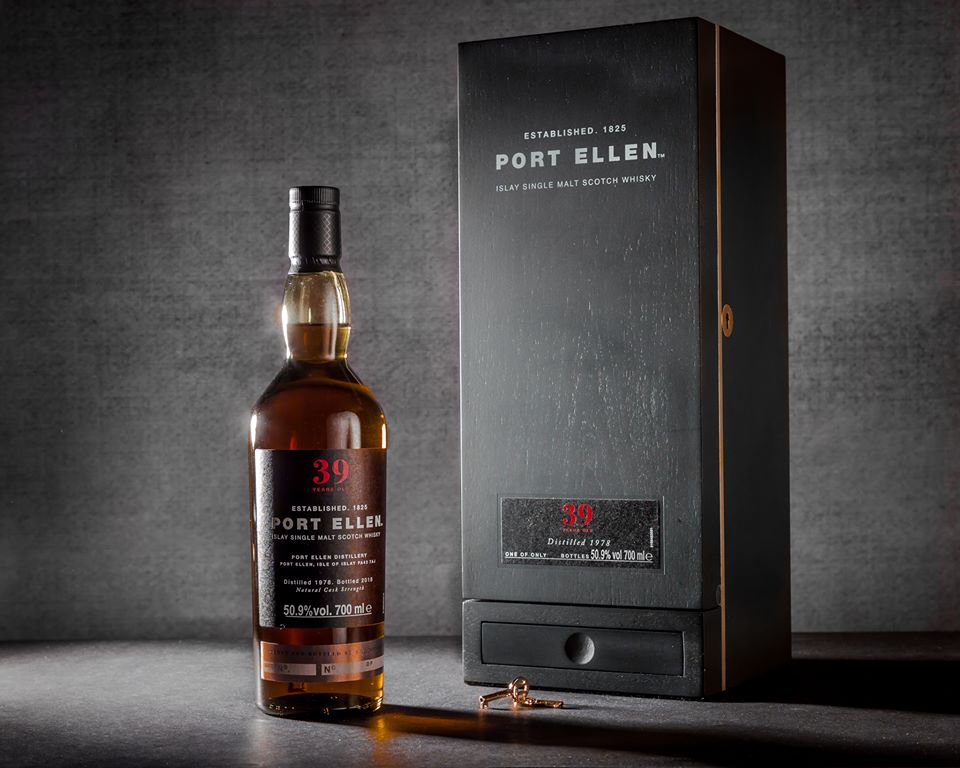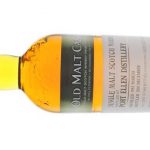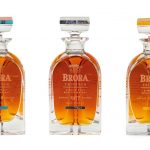Yesterday, a happy buzz went through the world of whisky. The Great News, in case you missed it, is this:
Brora and Port Ellen will be reopening.
Yes, it’s true: Brora. And Port Ellen. Will be. Reopening.
Yesterday, Diageo’s press release and other items concerning the great news were enthusiastically shared by dozens, perhaps hundreds, of whisky enthusiasts. And indeed, this is absolutely wonderful news. Both distilleries were victims of the radical closures of the early 1980s; Brora, because Distillers Company Limited had the newer Clynelish distillery to use for Johnnie Walker. Port Ellen, because it was basically a huge factory for making bulk whisky for blends, and these were not selling nearly as much as they had in the 60s and early 70s. Brora’s old stills are still intact; for Port Ellen, the old equipment is no longer there and new stills will have to be made.
In the case of Brora, it is easy to speak of reopening, as the old stills will be fired up again. For Port Ellen, this will of course be a new distillery housed where the old distillery was. This is how Scotch whisky history is written: when distilleries have been silent for decades and a new distillery is constructed where the old distillery was, it tends to be viewed as a reopening rather than a new distillery. One can compare with, for instance, Caol ila: if you are sipping a Caol ila distilled in 1970 and a Caol ila distilled in 1975 in another glass, you are actually tasting whiskies from two different distilleries – the old Caol ila having been completely demolished and ”rebuilt” at higher capacity in 1974.
Aaaaaaanyway. What do we know? If we boil down the press release to the bare facts focussing on the whiskies, this:
- The investment for restarting Brora and Port Ellen falls on roughy £35 million.
- The intention is to, as much as possible, make such whiskies are the distilleries used to produce. (I will be coming back to this point.)
- Brora, which during its long history made unpeated, medium peated and heavily peated whiskies, will, like Port Ellen, mainly be making medium peated whisky.
- Production levels will be around 800,000 LPA. The press release states ”The new Brora and Port Ellen distilleries will be among Diageo’s smallest distilleries, capable of producing 800,000 litres of alcohol per year.” I read this as being 800,000 per distillery. In Scottish terms, the distilleries will be very small indeed. One can compare with the already small Ardbeg, which can produce 1,400 000 LPA. In comparison to the bigger Caol ila, the new distilleries will each be making roughly 12% of Caol ila’s annual output.
- The aim is that the distilleries will be operational by 2020.
Also, it is clear from the press release that the production will be intended for release as single malt – something which should hardly raise an eyebrow.
A few words for thought:
- In what sense will Brora and Port Ellen be producing the same kind of whisky as before?
At several points, the people at Diageo assert that the whisky which will be produced is meant to resemble, as closely as possible, previous production at Brora and Port Ellen. The release is cautious, which is good; it says things like ”replicating where possible the distillation regimes and spirit character of the original distilleries”, and that they wish to “replicate as closely as possible the previous taste profiles of Port Ellen and Brora”. David Cutter at Diageo is quoted as saying “We will take great care to be true to the spirit of the original distilleries in everything we do”. (Emphases added.)
Now, this is not a simple thing to do. Simon and Phil Thomspon over at Dornoch distillery have gone to extreme lengths to try to create a new whisky made in the ”olden ways” (the 60s or even earlier, in their case). It is – probably – doable, but it does take a lot of time and effort. Will Diageo, even though the financial muscle is certainly there, really go all the way back to, say, earlier barley varieties with lower yield rates? Older strains of yeast? Lower-yielding mashing techniques? Of course they would say that the intention is to make the same kind of whisky as before. But are they really ready to sacrifice yield for older styles?
- How does one replicate earlier recipes?
When Ardbeg was awoken from its slumber in 1997, after a hiatus of not even a decade, nailing the recipe for Ardbeg’s new make was painstaking work. Previous employers were hired to help recreate the ”real” Ardbeg. Having the same stills and other distillery equipment does not mean that you will be producing the same spirit as before. In order to be able to distill ”new Port Ellen” in ways resembling old Port Ellen, you need to know exactly which cut points were used; how high the stills were filled; how slowly or quickly the stills were run; how long the fermentations ran; to name a few of the more crucial parts of whisky production. These things are very far from always written down, and especially so for a distillery which was closed 34 years ago. In an interview yesterday with Richard Woodard at scotchwhisky.com, Nick Morgan at Diageo reassuringly said ”We’ve got enough production records to know how these places were being run in the 1980s, and people still on the payroll who worked on those distilleries, so we can use that wisdom”. Of course they will be using that wisdom and of course there are some records, but it’s not going to be an easy ride, as witnessed by the case of the resurrection of Ardbeg. It is far from impossible, and I am certainly not saying that Diageo will fail in making spectacular whiskies at Brora and Port Ellen. But the work in getting there is very complex. Naturally, there is more to restarting a distillery than to just see to it that the equpiment works.
- When will Diageo be able to release whiskies from Brora and Port Ellen?
To some extent, this question has already been answered, at least in the form of stated intentions. The ever quick Ingvar Rönde simply interviewed Nick Morgan. This is what he learned:
Had a chat with Nick Morgan just now and the phenol level for both will be around 20ppm in the barley although they may be doing some heavier peated experiments as well. The two old pot stills at Brora will be used with new wooden washbacks, a new mash tun and new worm tubs installed. At Port Ellen two new stills will be manufactured equipped with shell and tube condensers. New mash tun and woodens washbacks as well. The two whiskies will be released as 12 year olds but there may also be limited earlier releases.
So now we know. Or, we think we know. If they fire up the stills in 2020 and all goes well, let’s hope for new 12-year-olds of Brora and Port Ellen come 2032. Richard Woodard received a similar response, slightly more qualified: ”We will probably release them as 12-year-olds, but that’s not to say we wouldn’t put out a very small release of something before then”.
However, it’s not all as easy as that, above all in the case of Port Ellen. Brora, which was called Clynelish before the ”new Clynelish” was built, used to be bottled at young ages and apparently the whisky was excellent even at five years old (no, I haven’t tried any of those bottlings myself). If Diageo succeeds in recreating some of the old magic of Brora/Old Clynelish, they will certainly be able to release Brora fairly quickly, even way before 12 YO.

Two whisky legends, Serge Valentin and Charles MacLean, sipping 5 YO Clynelish, bottled before the distillery was renamed Brora.
The issue may be more complex for Port Ellen. When Port Ellen was still up and running, its whisky was not held in high esteem. It was not until it was allowed to age fully that its qualities began to be recognised. Port Ellen is reminiscent of the legendary Japanese distillery Karuizawa in that regard: not preceived as great whiskies until the distilleries were closed, years passed, and the whiskies reached a higher age. If Diageo had decided to repoen Rosebank instead (oh, by the way, while you’re at it, please do), having a fully matured 10 YO would not be difficult. With Port Ellen, if they do succeed in recreating PE’s austere style of whisky, they just may have to wait a little longer than the twelve years mentioned by Nick Morgan. Or, they will release a 12 YO whisky which will be lauded by aficionados but found wanting by people unaccostumed to the demanding nature of ”young” Port Ellen. (There are certainly also many things you can do to see to it that a distillate has turned into a more than palatable whisky fairly quickly, and certainly within twelve years: you can experiment with quarter casks or even smaller casks, use higher phenol content in the malt for some special runs, lower-than-usual ABV strength of the new make at cask filling, more first- and second-fill casks instead of the tired, re-re-re-re-refill casks that were used at both Brora and Port Ellen towards the end. In all of these cases, you will naturally affect the whisky in ways which will make it resemble the old styles less rather than more, however.)
This is where you inject that since Diageo has more than just a little bit of cash, they can just wait until the whisky is ready, no matter whether that will be at 12, 15 or even 20 years old. Well, yes. Then again, maybe not. The brand name will still need be kept alive, and will the stock from the old distillery suffice for that many more years of Special Releases? What is more, one cannot underestimate the absolutely massive pressure that the whisky community will place on Diageo once Port Ellen is up and running. If representatives for Diageo want to talk about anything whatsoever but Port Ellen and Brora in whisky tastings for more than a decade, it will be difficult for them not to release any whisky. (Just consider how tiring it must be to be Francis Cuthbert at Daftmill: to always, always, always have to answer the question ”when will Daftmill whisky be released?” And there will be more questions concerning Port Ellen and Brora, no doubt…!) Finally, no pressure: the first new releases will have to be absolutely magnificent, since expectations will be exorbitant.
I am absolutely convinced the whiskies will be wonderful. Will they be as magical as aficionados are hoping? Let’s just say: we’ll see. There are very challenging times ahead for the teams working on these projects.
In his wonderful book Scotch missed, Brian Townsend wrote that ”Port Ellen is now beyond doubt a lost distillery”, and that ”Brora is definitely now a lost distillery”. Beyond belief, Diageo will prove those assertions wrong. This is a good time to be a whisky lover.
*
I usually blog in Swedish. For more posts in English, check here.





El Gold 10 oktober 2017
Great article David!
Erin 10 oktober 2017
Looks like you are getting your wish on Rosebank. https://scotchwhisky.com/magazine/latest-news/16403/rosebank-distillery-set-to-reopen/
Mikael Weisz 12 oktober 2017
Great article.
I’m very doubtful if Diageo will go to the length to use older barley varieties.
Also what many does not think about is for peated whisky the peat is harvested differently today.
The one difference is that today fluid is pressed out of the peat so that it will dry faster.
But this fluid even if it contains mainly water also contains minerals and other substances that is left in the peat if you do not press out the fluids before you start air drying.
Im convinced that these substances contribute to the flavor profile of the new make.
David Rowell 31 maj 2018
What an excellent and well considered article. The best commentary I’ve found on the re-opening/recreation of Port Ellen, and also some excellent points about the earlier expressions of Port Ellen prior to its closing, which I’d never understood or considered before.
Thank you.
David Tjeder 31 maj 2018 — Postförfattare
Why, thank you ever so much for that comment, David!